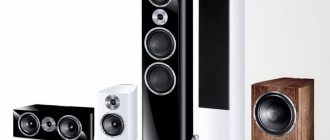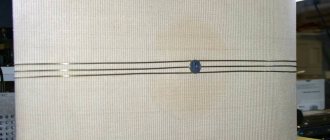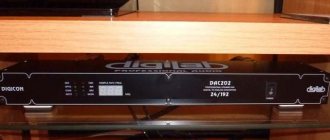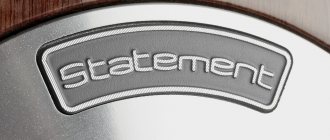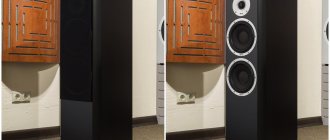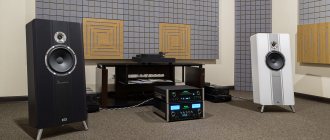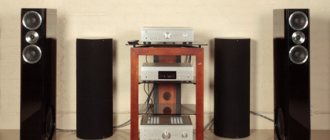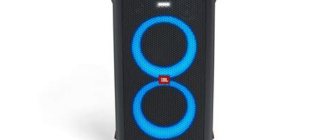My impressions of the Heco Celan Revolution 3 bookshelf
I turned to the forum several times for advice on choosing acoustics. I, in turn, want to help those who need it with their choice.
I’ll briefly write my opinion on the sound of “Celanov”. For a long time I was tormented by the choice of what to buy to replace the DALI Zensor 3 bookshelf. At the same time, I chose mostly blindly, since in our area there is generally nothing and nowhere to listen to. I wanted large, beautiful bookshelf speakers with large-scale, smooth and detailed sound even at low volumes. There are, of course, alternatives from Japanese vintage acoustics, which may sound even better (at least in terms of scale, width and depth of the stage), but I don’t like old things for a lot of money. At times, at the selection stage, I was inclined towards floor-standing units, but settled on shelf units.
It took a very long time to get there. Two months on the road. Two centuries ago we traveled about the same amount to Muscovy, since then apparently little has changed... The box arrived all dented, but the acoustics were ok. Still, the factory packaging is a reliable thing.
Setup: Pioneer N50 network player – Yamaha A-S1100 amplifier – Heco Celan Revolution3 bookshelf speakers.
First of all: very beautiful. Black, in piano lacquer. When I took them out of the box I wanted to hug them and not let go))). Well made. The rear terminal battery looks like a million rubles. On the Yamaha amplifier, the terminals seem to be of lower quality in comparison. The rear bass reflex is a work of art. Finished with some material that feels like stone.
The bottom speaker is paper (what you need), the tweeter creases at the slightest touch, very soft, it was harder on the censors.
I experienced the WOW effect from the first minutes of switching on. I don't understand what warming up is. Only your ears or brains are heated (self-hypnosis) and nothing more. If something doesn't sound right away, it doesn't sound. The sound may change in the future if you move the acoustics or furniture, but this is the effect of the room, not the heating.
The detail is amazing. Plays very smoothly throughout the entire range. Vocals, strings, keyboards sound very natural and natural. Metal sounds are also very natural without any assumptions. Plates are plates, a triangle is a triangle, etc. It also conveys the real feeling of a live voice. The bass, compared to the censor, has become clearer and more dynamic, while being lower and deeper. But in compositions with ultra-low electronic bass it can become humming. But I hardly listen to this. At the same time, in jazz the double bass is excellent. Bass in rock is excellent (all this is just my opinion).
I listen mostly at 8 or 8-30 o'clock volume. I don't want to turn up the volume any higher. Everything can be heard perfectly. But this apparently depends on the source and the level of its output signal.
I definitely recommend it, and with the specified amplifier. With Denon, I think the bass will be too bloated and the highs will be too bright. Perhaps for this money there are equally worthy or better classmates, but there is nothing to compare with.
All the best and good sound.
Characteristics:
General characteristics
| Manufacturer | Heco |
Main settings | |
| Acoustic radiation | monopolar |
| Kit contents | 2 loudspeakers |
| Type | shelf |
| Speaker type | passive |
| Acoustic design | bass reflex type |
| Bass reflex port location | rear |
Characteristics | |
| Number of lanes | |
| Bi-wiring | There is |
| Power | 100 W |
| Maximum power | 160 W |
| Sensitivity | 90 dB |
| Impedance | 8 Ohm / 4 Ohm |
| Minimum frequency | 30 Hz |
| Maximum frequency | 52000 Hz |
| Recommended amplifier power (min.) | 30 W / 160 W |
Connection | |
| Gold plated connectors | There is |
| Connector for connecting to a power amplifier | screw |
Emitters | |
| Emitter type | dynamic |
| HF emitter type | dome |
Design | |
| Removable grill | There is |
Additionally | |
| Width | 240 mm |
| Height | 420 mm |
| Depth | 360 mm |
| Weight | 10 kg |
Show all characteristics Speaker system Heco Celan Revolution 3
More than a year has passed since we became acquainted with HECO acoustics from the new audiophile Celan Revolution series.
Today we are returning to it again, and the object of in-depth study will be the floor-standing “sevens”, which - and we already know this for sure - are interesting not only because of their more affordable price relative to the larger older “nines”. HEADLINERS
In the last century, Germany could count several strong brands in the field of home audio reproduction, but the German school of Hi-Fi acoustics itself did not come to recognition immediately, but only with the debut of HECO Superior systems in the late 80s. But even at the beginning of the two thousandths, when other very worthy systems began to be found in audio salons, capable of competing with the “English” in accuracy, with the “Italians” in expressiveness and with the “Americans” in the power of reproduced sound, produced by German companies of the new wave (including can include Canton, Magnat, Quadral and partly ELAC), audiophiles looked at all this askance and preferred to spend money on acoustics from more famous brands in the world.
These are “revolutionary” Celan, the concept of which is 100% consistent with the original, but the implementation is modern: the housings have been redesigned, new wide platforms and advanced Fluktus dome-ring tweeters have been added.
The barrier of mistrust began to break down when HECO released the Celan series (2005). Passions boiled over in hi-fi forums - the first owners of these systems poured out so much delight that they even began to listen to them. And the brightest star of those times, by the way, was not the largest model in the new family, but the modest floor-standing Celan 700 – the great-grandfathers of today’s “sevens”. It is interesting that for more than ten years of production, the manufacturer has not deviated one step from the original idea - the design (three stripes, four heads) and type of drivers (cellulose and textile dome), dimensions and calibers, “tower” architecture and all technical characteristics are not were changed either in the second generation model Celan XT 701 or in the third generation Celan GT 702. For HECO, the series was a real engineering success.
It underwent a serious upgrade only very recently - the “revolutionary” Celan, the concept of which is 100% consistent with the original, but the implementation is modern: the housings have been redesigned, new wide platforms and advanced Fluktus dome-ring tweeters have been added. They were first shown at the Munich High End Show'2018, and in November of the same year we ourselves got acquainted with the flagships of the series - Celan Revolution 9.
The “Sevens” differ from them only in weight and size - each system is ten kg lighter, ten centimeters lower and slightly trimmed in other dimensions. But the slender, narrowed body, on which instead of a pair of 20-centimeter bass drivers there is a similar tandem of 17-centimeter ones, still has an impressive displacement. In terms of the lower limit frequency, judging only by the passport data, these speakers are inferior to the older ones by only 2 Hz.
The slender, narrowed body, on which instead of a pair of 20-centimeter bass drivers there is a similar tandem of 17-centimeter ones, still has an impressive displacement.
The rest is literally one to one. That is, a feast for the eyes. A solid milled aluminum support, a perfectly muffled front panel, profiled anti-resonance sidewalls and bass reflex “funnels” cast from metal give the Celan Revolution 7 such persuasiveness that any questions about their price disappear. Plus, they look like real all-rounders. High sensitivity of 92 dB, the presence of an advanced ultra-light 17-centimeter midrange driver (with a proprietary paper-wool diffuser and “old-school” corrugated suspension), a five-pole terminal panel that allows you to turn on the tweeter either in linear mode or with a slight rise (to compensate for HF absorption in overly muffled home theaters) - this is what makes the “Seven” the first candidates for purchase for any audio projects.
We already had a fairly warm steam at our disposal, so the initial installation did not take much time. As a significant plus, I will immediately note the wide range of orientation angles. Since Fluxtus tweeters have good and even dispersion, deviations relative to the listening point can achieve different construction of the sound stage and even highlight the desired part of the range. Turning inward, for example, slightly dampens the upper middle and thickens the “picture.” If you unfold the speakers, on the contrary, wider, the space will add volume on the flanks, and in the middle range the lower part will be slightly lighter (at first I liked this option more). And if you direct it strictly at the listener, then greater depth opens up in the center and the information content on the vocals increases. By the way, I recommend that you check the final angles on a monophonic signal - having achieved an absolutely clear axial focus between the speakers, you are guaranteed to receive “material” localization of all images in three-dimensional space. There are no problems with the scene here in principle.
If you unfold the speakers, on the contrary, wider, the space will add volume on the flanks, and in the middle range the lower part will be slightly lighter.
Dynamic qualities have always been Celan's strong point. The “sevens” have a lively and concretized interpretation, not constricted, but not overplayed. The entire musical range seems clear and natural, and when working from such an advanced amplifier as McIntosh, it is also very rich in subtle articulatory nuances, and they are not concentrated in any band, but are uniform across the entire spectrum. The frankness in the musical presentation weakens slightly only at the edges of the range. Higher ones – with moderate detail. The same applies to the lowest frequencies, although, to be honest, I didn’t really count on the passport “from 21 Hz”. Perhaps the systems reproduce such deep lows, but the real energy of the bass begins to reveal itself only from 35 hertz, and the texture and all the harmonics of the “seven” begin to play out in detail (it feels like) only from 50 hertz. But the main thing here is not the numbers, but the fact that They are still capable of performing everything brilliantly!
And the amplifier, from which no one expected much, convinced me of this. For the sake of idle interest, we connected the speakers to the compact Denon PMA-150H. At first it seemed that the reproduction became poorer and lost its comfortable character, but after twenty minutes of adaptation (after all, the contrast with the previous luxurious version was noticeable), the resulting sound began to literally drag on. The digital “Japanese” was able to do the impossible - he took the entire lower range under complete control! The components bordering on infrasound became frighteningly realistic (which is a big plus for engagement), the main bass acquired all shades of density and ceased to seem monotonous, and the midbass became even more distinct, textured and there was not a single static frozen note left in it either. The presentation in the lower band became smoother and calmer, but the music on such a “foundation”, oddly enough, became noticeably livelier. Paradox?
No “cotton wool”, no emptiness, only natural ringing (with a slightly silky tint) and quite pronounced “air”.
To return the desired warmth and openness to the middle, it turned out to be enough just to reorient the “sevens” strictly to the listening point. The upper midrange turned out to be clear, without unnecessary shades, and very informative. And on the HF, our new budget setup did not lose at all to the expensive system in detail and transparency - no “cotton wool”, no emptiness, only natural ringing (with a slightly silky tint) and quite pronounced “air”. Even the elaboration of space has been preserved: exceptional localization, confident layout in depth, including behind the speakers and outside the stereo base.
The only thing missing was a strong degree of presentation of the most powerful contrasts, which were easily provided by the much more expensive Macintosh. The not very powerful Denon, reaching higher levels, of course, lost pressure and speed, smoothed out the drive relief and “heated up” the sound not so much with power as with harmonics.
One way or another, the “sevens” seemed very friendly to amplifiers of any type. They do not “load” the terminals and allow them to produce their maximum quality. They sounded luxurious with a transformer amplifier when connected to the 8 ohm load terminals. They did not introduce “technical” shades into the sound, working with class D amplifiers. At the same time, the new “revolutions” of HECO in each case sounded with the same audiophile quality as all their predecessors - the most piquant shades could be heard on them.
This is bad news for those who do not pay enough attention to cables, vibration protection and acoustic tuning of the room. For such listeners, these speakers are too good; for complete harmony you will have to put your entire stereo system or home theater in perfect order. On the other hand, to get genuine joy from purchasing Celan Revolution 7, you don’t have to be a seasoned expert.
SYSTEM
- Sources
- McIntosh MCD350 turntable
- laptop Apple MacBook Air A1465
- Integrated amplifier/DAC McIntosh MA7200 and Denon PMA-150H
- Cables
- interconnect InAkustik Referenz NF-2404 RCA
- acoustic InAkustik Referenz LS-2404 Air
- digital USB InAkustik Referenz High Speed USB 2.0
- power InAkustik AC-1502 and P6
HECO Celan Revolution 7
Manufacturer: Magnat Audio-Produkte GmbH (Germany)
www.heco-audio.de
Configuration: 4 emitters, 3 bands || Acoustic design: bass reflex || Frequency range: 21 - 52000 Hz || Sensitivity: 92 dB || Resistance: 4 - 8 Ohms || Crossover frequencies: 250 and 2800 Hz || Nominal/maximum power: 220/350 W || Recommended amplifier power: 30 – 350 W || Finish: black lacquer, white satin, espresso veneer || Dimensions: 320 x 1182 x 390 mm (with supports) || Weight 1 piece: 29.5 kg
Source: salonav.com
